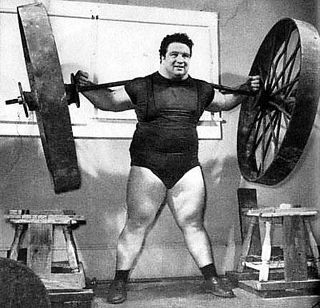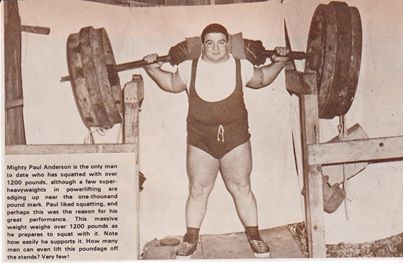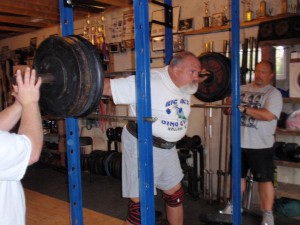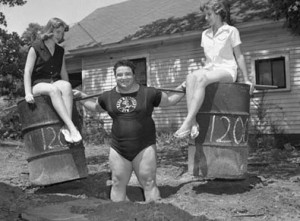by Al Myers

Paul Anderson training the squat with his iron wheels in Toccoa, Georgia. Paul's name has been "tied" to two new USAWA OTSM lifts.
I’ve already covered one of the new lifts approved at the USAWA Annual Meeting (The Curl – Reverse Grip). However, the big news in “lift approval” is the addition of several new Old Time Strongman lifts. The following OTSM lifts are NOW official lifts in the USAWA: People’s Deadlift, Anderson Press, Anderson Squat, and the Dumbbell to Shoulder. These 4 OTSM lifts have all been performed in USAWA competition over this past year as exhibition lifts, but now they are official lifts. Included in the motion at the meeting to accept these as new lifts was retroactively making any lift “record eligible” in these lifts that have been done over this past year. The Peoples Deadlift was part of the “Battle of the Barn” OTSM competition held be Eric Todd this past March, with the Anderson Squat, Anderson Press, and the Dumbbell to Shoulder being part of the 2011 USAWA OTSM Championships held by Thom Van Vleck last fall in Kirksville. In each circumstance, the lift was done according to the new accepted rules, so it seems only right to me that these past efforts be recognized by potential records.
One thing that I like to see with new lifts is that they have been done a few times as exhibition lifts in USAWA competitions before they become official. This way any “wrinkles” can be worked out in the rules, and only lifts will be presented for new lift status that have been “tried and tested”. The days are long gone where a lifter can just present a new lift at the National Meeting to be accepted without any prior written rules in hand or Executive Board approval. Now there is a SET POLICY in place (check the rulebook) so only lifts are presented that have been well reviewed. Most of our rule problems, as well as stupid lifts (and I’ll name them if you want me to), in the past have been caused by the hap-hazard way lifts used to be approved.
The Rules for these 4 new OTSM lifts are below. Soon they will be added to the Rulebook.
Peoples Deadlift – This is a partial deadlift, where the bar height must not be over 18″ from the platform (measured from the top of the bar). The plates or bar may be supported on stands, rack supports, or blocks to obtain this height. The lifter must have the bar in front of the legs, as in a normal deadlift. The hands must be on the outside of the legs (NO SUMO STANCE) during the entire lift. Lifting straps or any other gripping aid is not allowed. It is NOT an infraction to drag the bar up the legs, bounce the bar up the legs, or support the bar on the legs during the lift (hitching). A one minute time limit is allowed for the lifter to make a legal lift, during which time a lifter may make multiple tries. Once the lifter is totally upright and the bar motionless, an official will give the command to end the lift.
Anderson Press – Press (with a standard Olympic bar) will be done from a dead stop position in the power rack from a height no greater than the height of the lifter when standing erect. Lifter may “bow” back to press the weight but must keep knees locked. The lift ends when the lifter is upright, arms locked, and demonstrates control of the weight. The lifter may press in an uneven manner and unlock unevenly. It is not a disqualification if the bar is lowered during the press, and afterwards the press resumes. The feet are not allowed to move. However, the lifter may raise the heels or toes during the press. Time limit of 1 minute is given for each attempt meaning the lifter may reset as many times as necessary to complete the lift. An official will give a command to end the lift.
Anderson Squat – A squat (with a standard Olympic bar) done from a dead stop from a height not over two thirds the height of the lifter. Squat is completed when the knees are locked and the lifter is standing erect. Time limit of 1 minute is given for each attempt meaning the lifter may reset as many times as necessary to complete the lift. Knee wraps or knee sleeves will be allowed. An official will give a command to end the lift.
Dumbbell to Shoulder – A Dumbbell will be taken from the floor to the shoulder using any method the lifter wants to employ. The dumbbell may be lifted with two hands, continental style, may be rested on the belt during the lift, by any part of the dumbbell. Hands may grip the plates, bar, collars or any part of the dumbbell. Any size plate may be loaded onto the dumbbell.The lift is completed when the lifter is standing upright, with the dumbbell resting on the shoulder, and the lifter demonstrating control. Both hands may remain on the dumbbell to complete the lift, or with one hand or both hands off the dumbbell. Time limit of 1 minute is given to complete the lift. An official will give a command to end the lift.



